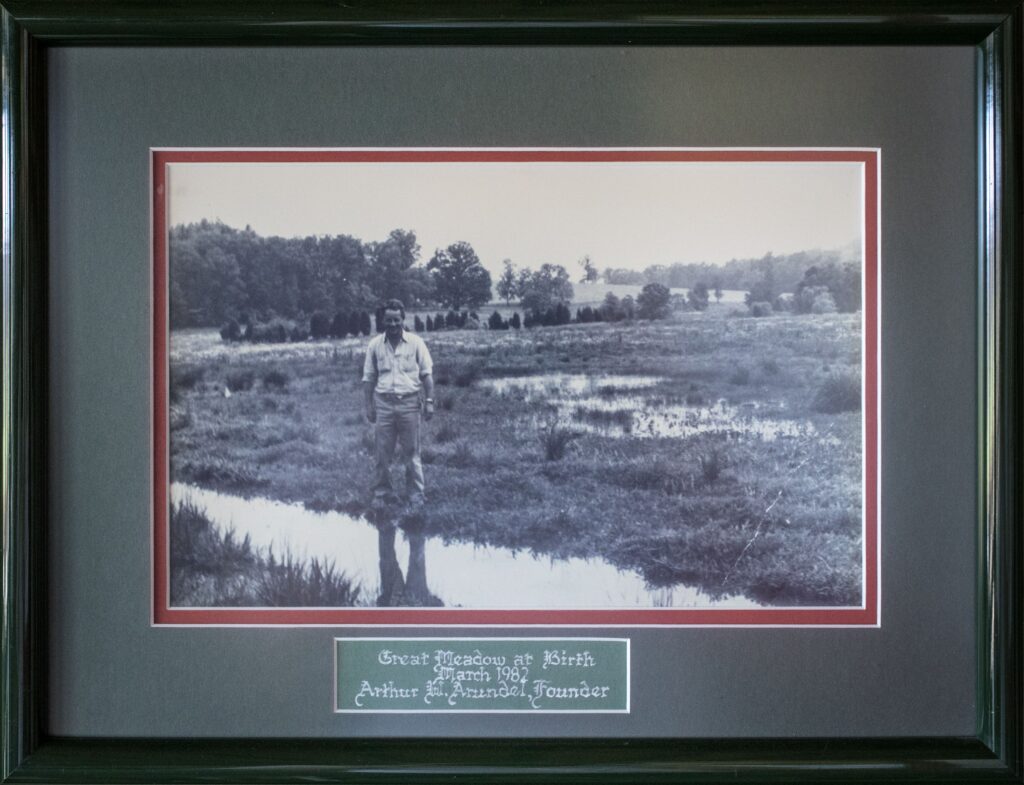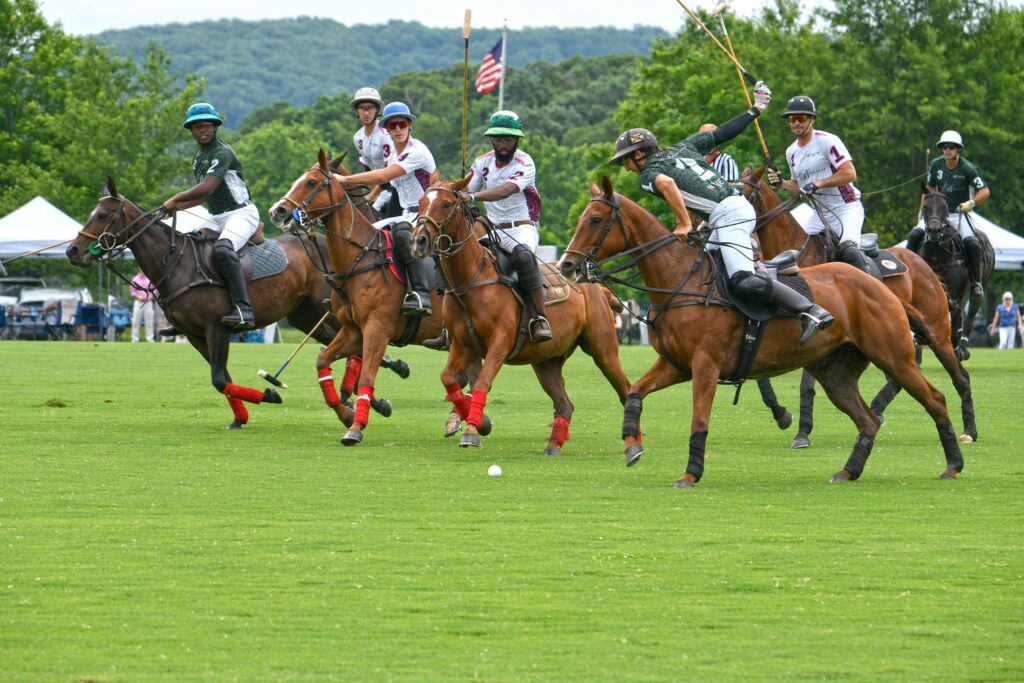Great Meadow Celebrates 40 Years in The Plains

Written by Heidi Baumstark
One man’s field of dreams transformed into a dream come true for millions.
That field – now Great Meadow – is the nation’s premier equestrian field events center located in The Plains, which is the heart of Virginia’s Hunt Country.

And that man was news executive, equestrian, and philanthropist Arthur W. “Nick” Arundel (1928-2011) who in 1982 finalized the purchase of a property he envisioned would become the permanent home for the Virginia Gold Cup steeplechase races, plus other field events, with the added value of preserving open space and averting a planned housing development.
Today, Great Meadow is a 374-acre field events center and steeplechase course which operates under the stewardship of the nonprofit Great Meadow Foundation (GMF). With the 1982 purchase of the property – and then its grand opening in 1984 – Great Meadow plans to commemorate its 40th anniversary over the next three years. Carrie Hull, GMF’s executive director, shares, “Celebrations are being planned to recognize milestones of what would become the permanent home of the legendary Virginia Gold Cup each spring. After all, that was the major reason why Nick purchased the property.” Overseeing it all, Arundel is immortalized in a bronze statue on Members Hill.
In addition to the Virginia Gold Cup, Great Meadow hosts many other events including the International Gold Cup, Twilight Polo, Mars Great Meadow International, Fourth of July celebrations, and The American Rocketry Challenge. Hundreds of thousands enter the gates each year to witness top-level equestrian sports and festivities against the backdrop of the majestic Bull Run Mountains.

Who Was Arthur W. “Nick” Arundel?
Arundel, a native of D.C., graduated from Harvard University in 1951. Following Harvard, he served as a U.S. Marine Corps paratrooper officer in Korea where he was wounded, earning him the Purple Heart. He rose to the rank of captain and was an attaché to the CIA in the Vietnam War where he was again wounded earning a second Purple Heart. He left the Marines in 1955 and became a Defense Department correspondent for the Washington bureau of CBS News covering D.C., and later, the White House, for United Press International.
Notably, Arundel was also a founder and president of the Piedmont Environmental Council, the co-founder of the National Press Foundation, and a 2001 inductee into the Hall of Fame of Virginia Communications. He was also named Outstanding Virginian in 2011 by the Virginia General Assembly. He died on February 8, 2011, at the age of 83 at his beloved home, Merry Oak Farm on Wildcat Mountain near The Plains.
Building Great Meadow
While searching for the new home of the Virginia Gold Cup, Arundel found Fleming Farm in The Plains, known by locals as the “old crayfish field.” The site was an overgrown, swampy dairy farm. He purchased it at a bankruptcy auction on the steps of the Fauquier County courthouse, acquiring it through a trust he had established.
“He needed to gather the support of the community to build the racecourse,” Hull explains. With the dual motive of using it for the Virginia Gold Cup and protecting the open space, Arundel purchased the property for two million dollars and gifted it to Meadow Outdoors Foundation. In 1996, the foundation was renamed Great Meadow Foundation.
Construction of the racecourse began in April 1982. Two years later marked the grand opening during which a gathering of some 3,000 guests enjoyed festivities including carriage driving, foxhound demonstrations, and skydivers. Arundel, along with local point-to-point jockeys, galloped horses through a ribbon to formally open the course.
On October 20, 1984, the first annual Great Meadow Races, later known as the International Gold Cup, was held. And, May 4, 1985 saw the first Virginia Gold Cup at Great Meadow with a record 32,000 spectators.

Polo and More
Arundel’s son, Peter Arundel, founded the Great Meadow Polo Club, bringing polo to The Plains for the masses to enjoy.
Peter remembers a conversation over dinner one evening in 1992, when he first brought the idea to his dad: “We could do arena polo on Friday nights,” he said. “My father replied, ‘Yes, there’s not enough going on around here anyway on Fridays, so let’s go for it.’” In 1993, the arena was built (now Greenhill Stadium) for polo, horse shows, and rodeos.
In June 1994, the first arena polo games were held on Friday nights under the lights at Great Meadow. “Suddenly, arena polo became more accessible,” Peter recalls. “People could see polo, smell the sport, hear the pounding of the horses.”
Though Peter was away at college when his father purchased Fleming Farm he shares, “[From] what I remember, it was when the parties started.” “Festivities like wine festivals were held there in the 1990s, as well as activities including rocketry groups, astronomy clubs, soccer, therapeutic riding, and high school cross country. “It was very important to dad and the foundation that it be open to all, not just for equestrian pursuits,” Peter explains. That same theme of inclusion and accessibility extended to their concept of polo. “With arena polo, we took it to a whole other level,” Peter says.
In addition to arena polo, grass polo is played on the Sheila C. Johnson field. Built in 2004, it is home to the National Sporting Library & Museum’s Polo Classic.

In 2006, professional polo player John Gobin joined Great Meadow. He suggested shifting polo from Friday to Saturday nights to avoid rush-hour traffic for spectators. The event also adopted a more family-friendly format by including activities such as the famous tug o’ war during halftime.
In February 2014, then-president Rob Banner nearly doubled the size of the Great Meadow with the purchase of the adjacent 174-acre parcel of Fleming Farm, bringing the total size of the property to 374 acres. This expansion allowed for construction of additional infrastructure including a large all-weather, world-class arena referred to as the Fleming Farm Arena. This site was chosen to host the first FEI Nations Cup™ Eventing series ever held in North America in 2016. The event welcomed the best horses and riders in the world to Great Meadow to compete in three distinct disciplines: dressage, show jumping, and cross country. “Beyond creating the initial racecourse, this arena was the next biggest project,” Banner says. Ultimately, it would establish Great Meadow as an international equestrian facility.
To ensure Great Meadow would be forever protected from development, the property was placed in a conservation easement with Fauquier County in 2014.

Great Meadow Today and Tomorrow
On January 1, 2022, Natalie Miller Epstein took over as Chairman of the GMF Board, a position previously filled by John Hochheimer. She shares, “I am very passionate about Great Meadow as it is truly a gem in our own backyard. I have great respect for Nick and his vision for Great Meadow. It is now up to us to carry that vision forward to ensure that this extraordinary place in the Virginia Piedmont remains here for future generations.” She continues, “To that end, there is much to do not only to maintain the gorgeous grounds and historic buildings and structures that are Great Meadow, but also to expand on that original vision to continue to serve everyone in the greater community and, in the case of some events, the global community, as well.”
“I never met Nick. But before making a decision about the property, I always ask myself: ‘What would Nick do?’ His vision for this place was remarkable. People didn’t believe the property could be turned from a swamp into the country’s best steeplechase course,” Hull shares.

Great Meadow is something far beyond the events that are held there. “Throughout this three-year celebration of our 40th anniversary, we want people to understand the emotion and passion that went into its establishment,” Hull explains.
“I’m sure Nick would be cheering from Wildcat Mountain,” Banner adds. “He would be so pleased that we took Great Meadow to the next level. Considering the natural beauty of the property, the site is a wonderful promotion of open space, a cathedral of beauty, and now privately protected through a conservation easement. I’m really proud we were able to carry on Nick’s legacy.”
When asked why he was giving so much of his time and effort to the undertaking, Arundel is quoted as saying, “I just want to give something back to this sport, further open space, visual order, and the spirit of volunteerism here. In the first third of your life, you learn; in the second, you earn; and then finally, you give it all back.” ML
This article first appeared in the March 2022 Issue.


